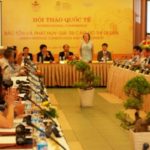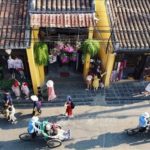Due to climate change and the changing ecological environment, the red-crowned crane has not returned to the park in the past two years. Dong Thap is currently working on a conservation project in order to bring the birds back to Tram Chim.
Huynh Thanh Tuoi, a member of Tram Chim National Park’s specialized protection group, skillfully navigates his boat into the area where restoration work is being carried out. With 10 years of experience working in the National Park, Tuoi understands that the cranes will only return to Tram Chim during the dry season when they can find food.
Red-crowned cranes are typically observed in Tram Chim from December to April. However, if their preferred food is not available, the birds will migrate elsewhere, Tuoi explained.
“I used to see a lot of red-crowned cranes here every year a few years back. But they have stopped coming. Although water chestnuts, the cranes’ favorite food, are available, the birds have not returned yet,” Tuoi shared.
According to a report by Tram Chim National Park, one of the reasons for the cranes’ absence is the severely degraded natural ecological environment, particularly the natural wetlands and agricultural production areas.
In the 1980s, Tram Chim National Park would witness the arrival of hundreds of red-crowned cranes during winter, and they would stay until spring. The absence of these birds now leaves the staff concerned. The Tram Chim National Park team remains hopeful that the cranes will return someday. Tran Quoc Vuong, who works at Tram Chim National Park’s International Cooperation Research Department, expressed his thoughts.
“The rare crane holds great spiritual and cultural significance. It is the symbol of Tram Chim National Park. Their presence signifies a deeper connection between people and nature,” Vuong said.
In May of this year, Dong Thap province launched a project to conserve and develop red-crowned cranes at Tram Chim National Park. The main objective of this project is to raise 150 cranes within a ten-year period starting from 2023. It is expected that at least 100 of these cranes will survive and thrive after being reintroduced to their natural habitat.
The $3.7 million project also aims to improve the habitat of the cranes, establish an organic agricultural production area around the park, create a sustainable environment for the birds, and involve local communities in their protection efforts.
Doan Van Nhanh, Deputy Director of the Center for Conservation and International Cooperation at Tram Chim National Park, stated that preparations have been completed to welcome the red-crowned cranes imported from Thailand at the end of this year.
“The conservation process is based on the ecological needs of the red-crowned cranes. Typically, the birds leave in May. However, this timing may vary depending on the weather conditions, which are determined by the amount of rainfall. Their breeding season falls between June and July, during the rainy season. Our utmost hope is to successfully raise the cranes until they can reproduce,” Nhanh said.
Dong Thap province has signed a memorandum of understanding with the International Crane Foundation and the Vietnam Zoo Association to bring the red-crowned crane from Thailand to Tram Chim National Park. The province has trained its staff, developed its facilities, and closely monitored the cranes’ habitats in both the core and buffer zones of Tram Chim National Park.
Tram Chim National Park has been recognized as the world’s 2,000th Ramsar site. The conservation and development of red-crowned cranes in the park contribute to biodiversity conservation and play a significant role in protecting these birds, who are on the brink of extinction.
Enhancing Operational Efficiency at Vietnam’s World Heritage Sites
NDO—Nhan Dan recently published a Vietnamese-language story calling for an immediate end to the organisation of parties in the caverns at Ha Long Bay, which revealed typical shortcomings in the management of World Heritage Sites in Vietnam. But we must look no further than some limitations of the current management model to uncover the main cause of such confusion.
Keeping Trang An heritage title
NDO – A variety of classical karst towers and a network of caves connected by an intricate system of subterranean waterways, sunken hidden vestiges of ancient Vietnamese people, traces of invasions by sea, geology and geomorphology evolution and many sacred ancient temples and pagodas are the outstanding global values of Trang An Landscape Complex – the world’s mixed cultural and natural heritage.








